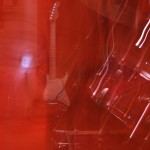Thought you might like my interview on why we started Tone Ninja and why we manufacture guitar nuts:
Most serious guitarists invest lots of time searching for that magical, and sometimes elusive tone they hear in their heads. During this process, they often enjoy testing everything from different guitar models, amps, effects pedals, strings and even cables. They don’t however, give much thought to the nut that is the main support for the strings they play on daily. This tiny yet critical piece of the instrument is what allows the strings resonate properly. Let’s be honest, most guitarists don’t really consider this to be of primary importance until something goes wrong with the guitar!
When tuning issues, sustain or buzzing arise, the nut can be the culprit. An improperly shaped or slotted nut can make a great guitar sound or play poorly, while a properly cut and installed nut can often make an average guitar much more playable and resonant.
I don’t pretend to be an expert when it comes to guitar nuts, but I have installed several nuts on my guitars over the years. I can therefore appreciate how difficult it can be to get a nut shaped and filed and slotted properly. It also requires quite a bit of time to get it right.
There are quite a few different materials one can choose when selecting a nut for an installation. Typical materials include, bone, brass, Corian, graphite, plastic and a host of other materials. The question often asked is whether or not the material used when fabricating a nut makes a real difference in tone? Sure there is a lot of Voodoo theories floating around the internet these days, but what is the honest truth?
To answer this question, I decided to contact Andrew Marshall from Tone Ninja who understands the technology behind guitar nuts intimately. Andrew is the founder of the Tone Ninja brand that fabricates a wide variety of guitar nuts for easy installation and great tone. I asked Andrew to help shed some light on a few common questions relating to guitar nuts in the hopes of getting a better understanding of what makes a great nut.
Andrew, first off, why did you decide to start a company based on guitar nuts?
It’s an idea we’ve been kicking around for a couple of years, and as with most of these things there were several influencing factors. Firstly, up to now there’s only been one company producing nuts for the replacement and upgrade market, and there’s definitely room for another. Secondly, there’s no line of nuts available for the broader market that are made in the USA, and a majority of our customers both domestically and abroad have a strong preference for US manufactured products. Third, we thought we could definitely build a technically superior product at a lower end-user cost. Fourth, as with almost everything in the music industry, it was a lot of fun and a very gratifying experience. You get to work with great people and produce something people love. Finally, nobody’s really done anything new with nuts for thirty years so we thought it was about time.
Over the years guitar nuts have been made from everything from bone, Corian, various plastic materials, graphite and even brass. What material are your guitar nuts made from and why did you choose this material specifically?
Ah, the voodoo question. As you probably know, many people have strong opinions on this, and I’ve learned a lot in the process listening to guitarists and trying to parse those opinions into a material specification. We engaged materials engineers in the process and went through several iterations before we arrived at the current material, which is a high performance engineering copolymer. The trick was to find a material that was wear resistant and had a great (i.e. low) coefficient of friction and was easy to work if needed. Then, it had to produce reliable results to very high engineering tolerances when fabricated and on top of all that have consistent density for tone transmission. It was quite a task, but we’re very pleased with the result.
Guitarists often think bone is the best material to use when making a guitar nut. What are your thoughts on this?
Bone is a fantastic material, and if you have the time, skills and tools to fabricate your own nut it’s a great choice. For most guitarists, that’s not really a viable option, so that’s where we come in. We think our nuts are as close as you can get to a luthier fabricated bone nut as you can get with a prefabricated product. As an aside, bone only comes in one color, which is, well, bone color, and that can be incongruous on many instruments.
What are some benefits I can expect to notice after installing a Tone Ninja nut?
Every instrument is different, of course, but the immediate benefits are playability and tuning stability. Open string resonance should improve too. In most playability problems we see, the nut is contributing to the problem – either too high or too low, or with one or more slots too deep or too shallow, or the wrong shape, or too wide or too narrow – you get the idea.
What are the main points I should think about when considering a nut upgrade for my guitar?
How hard will it be to change the nut, and will it make a difference should be the top two. We’ve tried to make the replacement process as easy as we can, and in most cases the slots should work as is. Will it make a difference? The nut is often overlooked as ‘too hard to fix’ when doing a setup, but in many cases it’s the problem that needs solving.
I have a slipping G string on one of my more expensive guitars. Why is this happening, and can a good quality nut fix this issue? If so, why don’t guitar manufacturers install better nuts on their guitars?
Binding on the G or B string is a common problem – the dreaded ‘ping’ when tuning. It can be caused by a couple of things, commonly a malformed slot or a sticky material. Using a nut with well-engineered slots and a high material lubricity will overcome most if not all of those issues.
Even with more expensive instruments, they’re built to a price. This is reflected not only in the nut material but also in the labor hours that can be spent at the factory getting the nut set up exactly right. The slots on most mass produced nuts are not that well engineered, which doesn’t help. Also remember the factory setup is very generic and may not suit what you need.
I have occasionally seen people using a brass nut in place of a plastic or bone nut. Are there any advantages to brass over the other materials?
Brass was pretty popular in the late 70’s, but apart from Yngwie’s brass strat nut which is available from Fender as a separate part, it isn’t used much today. It obviously wears well but it’s also pretty hard to work and relatively expensive. It sounds quite bright. It’s actually one of the materials we compared against when developing Tone Ninja nuts.
There are some people that believe a guitar nut if properly slotted has little impact on guitar tone. Fretted notes leave the nut out of the equation so nut material has little if any impact on tone. They often point to locking tremolo systems that do not actually use a nut yet still achieve good tone. What do you think about this argument?
It’s much more about how the nut, its fit, and its slot engineering affect playability and tuning than the actual vibration transmission, and you hit the nail on the head in the question with ‘properly slotted’. Some people in the industry are definitely guilty of over-stating the nut’s contribution to tone, and you’re quite correct that when a note is fretted the nut isn’t in play. Let’s not ignore open strings though, and there the material can make a significant difference.
However, let’s explore a different factor of tone: What we really mean by tone is how a guitar sounds when played. You’re probably familiar with two effects: one, when you pick up a guitar that just plays really well, you feel more connected to what you’re playing and the overall result is just somehow better, and two, when what you play sounds really good, it lifts your opinion of your tone? A properly set up guitar that stays in tune, and has great playability will start that positive feedback loop that improves your opinion of your tone, your own opinion of how you sound.
It’s not a panacea, it has to be in conjunction with many other factors – but if your nut is wrong, it will be hard to achieve good playability and hence ‘tone’, and that’s how our nuts really affect your tone.
Do you think someone can pick out a guitar with a bone nut or a plastic nut just by listening to them being played side by side?
Same guitar, same strings, open strings, acoustically? Possibly. I’m sure you could measure it with a spectrum analyzer. The reality is though, that bone is not practical or accessible to most guitarists and the acoustic difference between the material we use for Tone Ninja nuts and bone is small. Most people wouldn’t hear it. Cheaper plastic nuts? The difference would be more obvious.
Andrew, thank you very much for taking the time to answer some of our questions. I am looking forward to installing a Tone Ninja nut on a guitar that I am in the process of doing some mods to. Where can our visitors get some Tone Ninja nuts if they wish to purchase some?
They can simply visit us at www.sporthitech.com and place an order online. We have many models and sizes available for most any type of guitar.





























